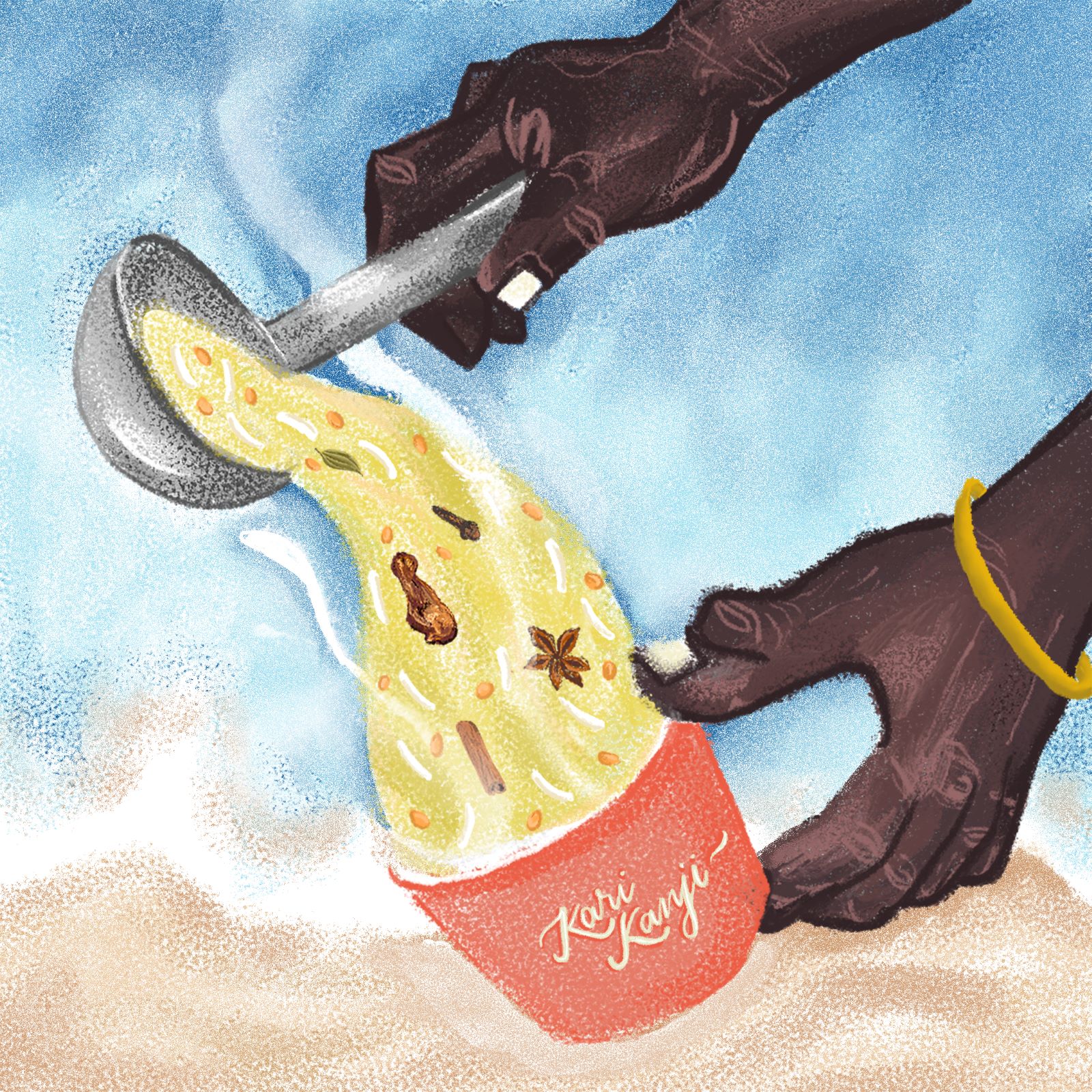Kayalpatnam’s seaside is home to a unique treat, kari kanji. Sumaiya Mustafa tells us about the history of this unique dish from her hometown.

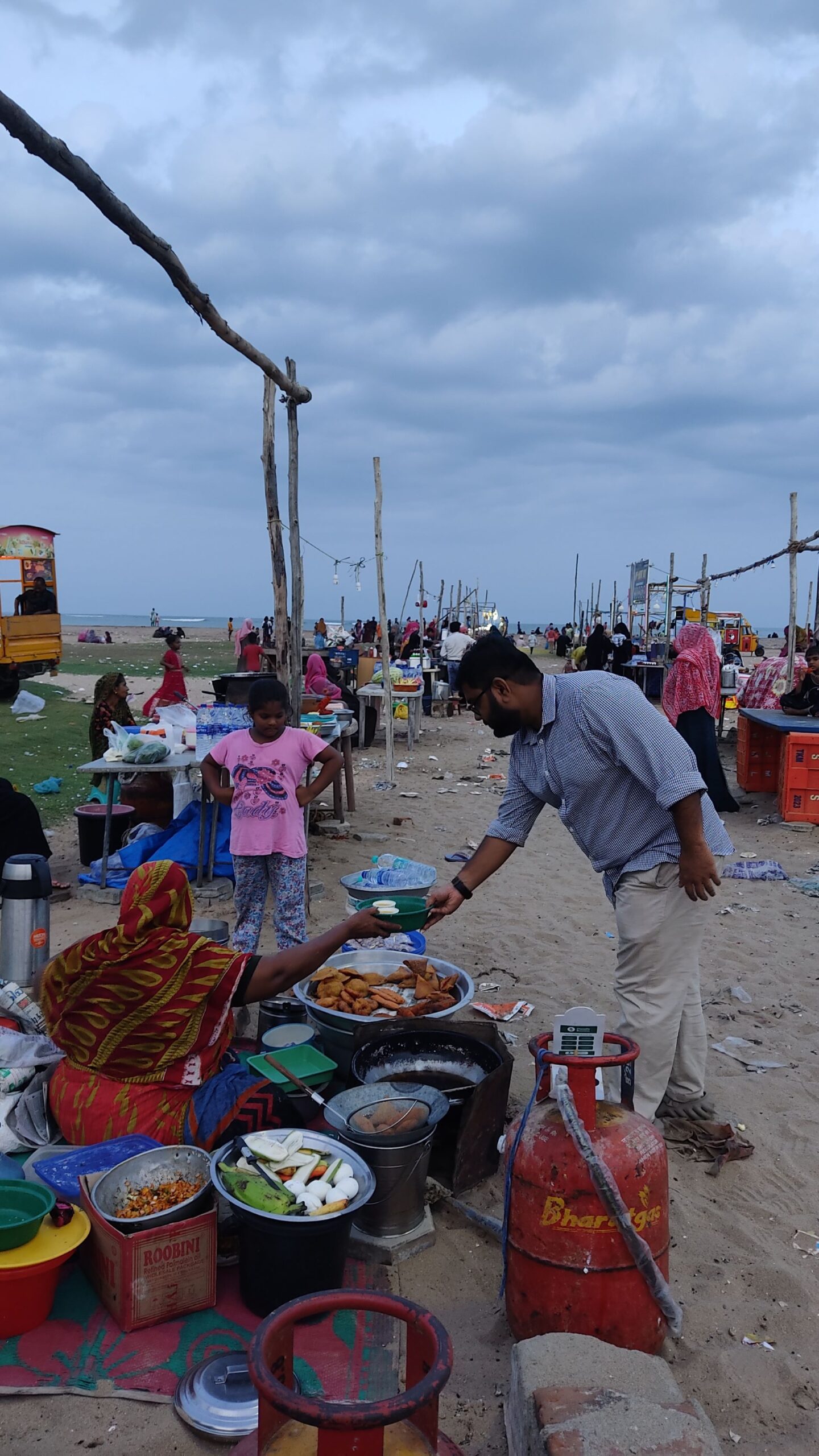

The sun turned its knob to full that evening and the beach in Kayalpatnam, a small town in Tamil Nadu’s Thoothukudi district, also my home, is filled with sunlight. People sit in puddles all over the widely spread golden sands of the shore. Most can be seen sipping plastic cups of a yellow-hued savoury drink. It’s neither soup nor porridge. It is piping hot Kari Kanji, a drink that beats heat with heat. Kari in kari kanji stands for meat in Tamil. The other meaning of kari is anything that is cooked, while the literal translation of kari is “to char”. Kanji stands for any rice- and lentil-based semi-solid gruel in Tamil. Sometimes it is a fermented pap.
Here, on the beach, it is unfermented and consumed fresh and starchy. Amidst the relentless splash of the waves on the turquoise-blue Bay of Bengal, hot air emanates from the seaside. Young boys clad in veshtis play football, wearing jerseys named after global football names. Middle-aged men with a fez or skull cap sit with other middle-aged men getting chatty while women with dark veils chat amongst themselves or run behind the kids. These are the locals of this seaside town. While their presence is sporadic, the beach is a fulcrum of recreation for young and old, and for families and friends from the neighbouring villages and towns. Everyone who comes here rarely goes back home without sipping kari kanji.
What breathes life into Kari Kanji’s array of ingredients are pandan leaves. Locals call it rambe elai and love tempering practically every dish with it.
Kari Kanji is an amalgamation of rice, moong dal, cuts of meat (for the most part this is beef, typically served at commercial eateries and among seaside vendors), and home-ground curry masala – usually made with red chillies, coriander seeds, cumin, and fennel. Fistfuls of coriander and mint leaves also go in. Creamy coconut milk also makes its way in via the abundance of coconut trees in Kayalpatnam’s landscape. To make Kari Kanji, all these ingredients are boiled in a cauldron until the rice and lentils bloom. If you stop to read through the ingredients in a Kari Kanji, it’s easy for you to believe and imagine that it tastes like a liquified Biriyani. The grainy mouthfeel of the gruel together with the awakening olfactory delights like coriander and mint leaves with the smell of cardamom, cloves, and cinnamon create an experience that is of sipping Biriyani.

Traditionally, Kari Kanji was hand-blended with a wooden kitchen implement called the mathu. But in recent years, the mathu has been abandoned and has been traded in for electric hand blenders. The denizens of Kayalpatnam are the most pragmatic thanks to their long-standing disposition as a maritime trading community. They have been in constant touch with global culinary techniques, thanks to expats living in almost every corner of the town. Indeed, the townspeople (including my family), call an electric hand-blender “kanji kadaira machine”, meaning the “machine that blends kanji” despite being used for a variety of reasons in the kitchen.
What breathes life into Kari Kanji’s array of ingredients are pandan leaves. Locals call it rambe elai and love tempering practically every dish with it. This Southeast Asian aromatic herb is a widely unknown culinary secret throughout Tamil Nadu. Kayalpatnam’s geographical position – as an Indian Ocean littoral, as an important trading post in the mediaeval period in between the maritime silk route and the spice route, and as a haven of seafaring Tamil Muslim traders – has kept the town exposed to culinary influences from other ports and trading posts. The monsoon winds favoured the globalisation of Indian seaside towns much before the 20th-century globalisation of mainland India and its free markets.
It’s easy for beachgoers to sulk at the amount of loitering and littering brought in by commercial activity. To vendors, however, crowded beaches are treasure chests.
Kayalpatnam was an erstwhile trading post on the Indian Ocean trading routes in mediaeval times. In the 13th century, the town was in its heyday, with (actual) horse trading from Basra to Batavia, and beyond. In this predominantly Muslim town of Tamil speakers, a few influential traders were part of the mediaeval merchant guilds of South India, such as Anjuvannam and Ainooruvar. The traders in these communities were constantly on the move, their trade needed them to be itinerant. The women they took as wives did not move in with them. The wives stayed in their maternal homes. Their husbands visited them whenever the routes of the trade brought them home. This was a common and convenient social arrangement among trading groups with partial Arab descent in coastal parts of South and South East Asia. This system of living, known as matrilocality, weakened during colonial and post-colonial times when family-based businesses verged on obscurity. Strangely enough, Kayalpatnam still closely guards this social arrangement.
For me, a millennial who grew up in Kayalpatnam, kari kanji on the beach is a story of substance. I say this because, until the late 1990s, this beach was not considered to be a place for women. Men did go to the beach, but it was not a site of placemaking for them either. They had masjids and neighbourhood sports societies. The beach was mainly meant for boats, fishing nets, and fisherfolk.
When families started arriving there for recreation, it slowly became a place to hang out, to gather, and make merry. For a while, in the late 90s, roasted peanuts and water packets were all we could get our hands on on the beach.
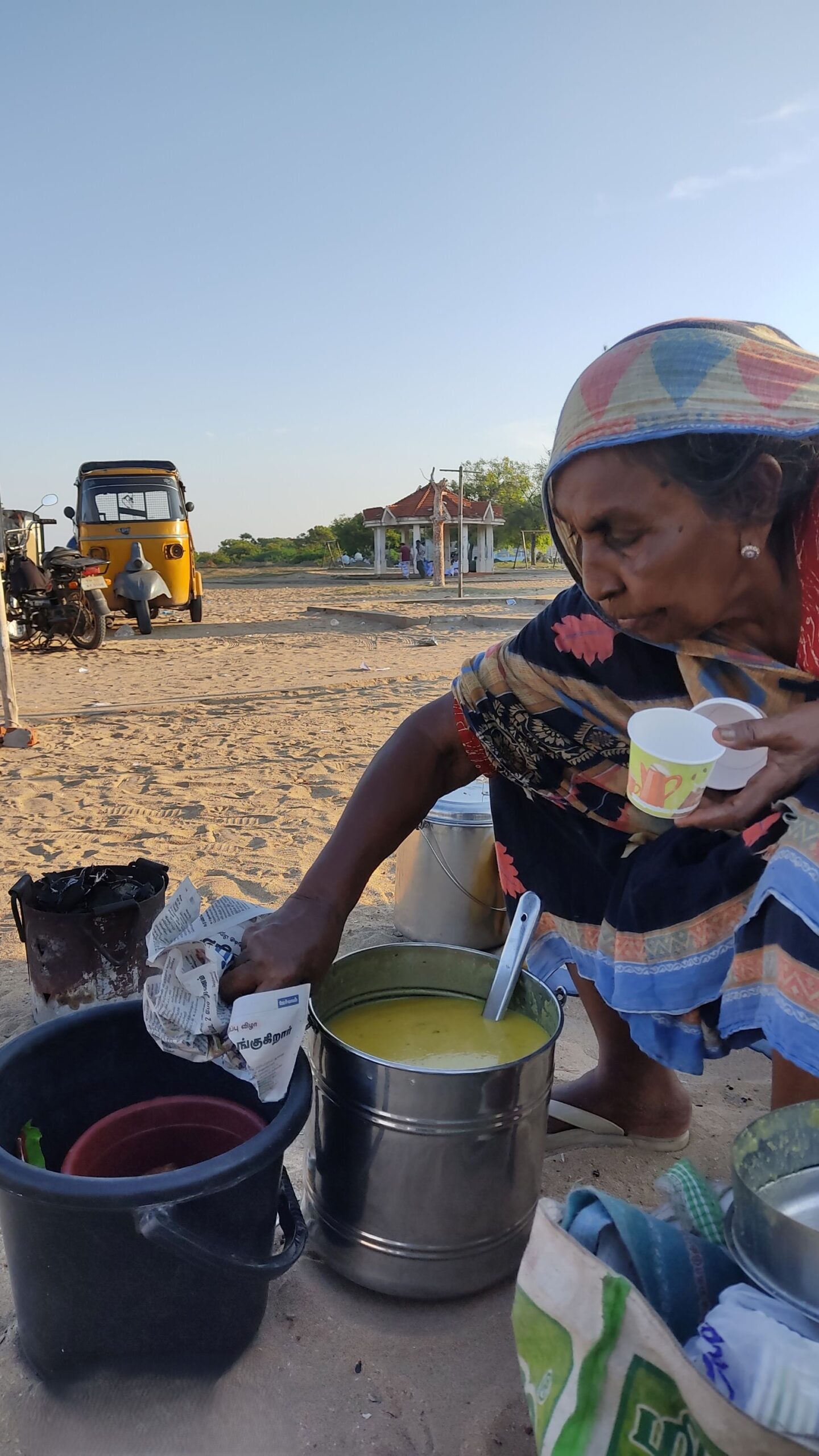
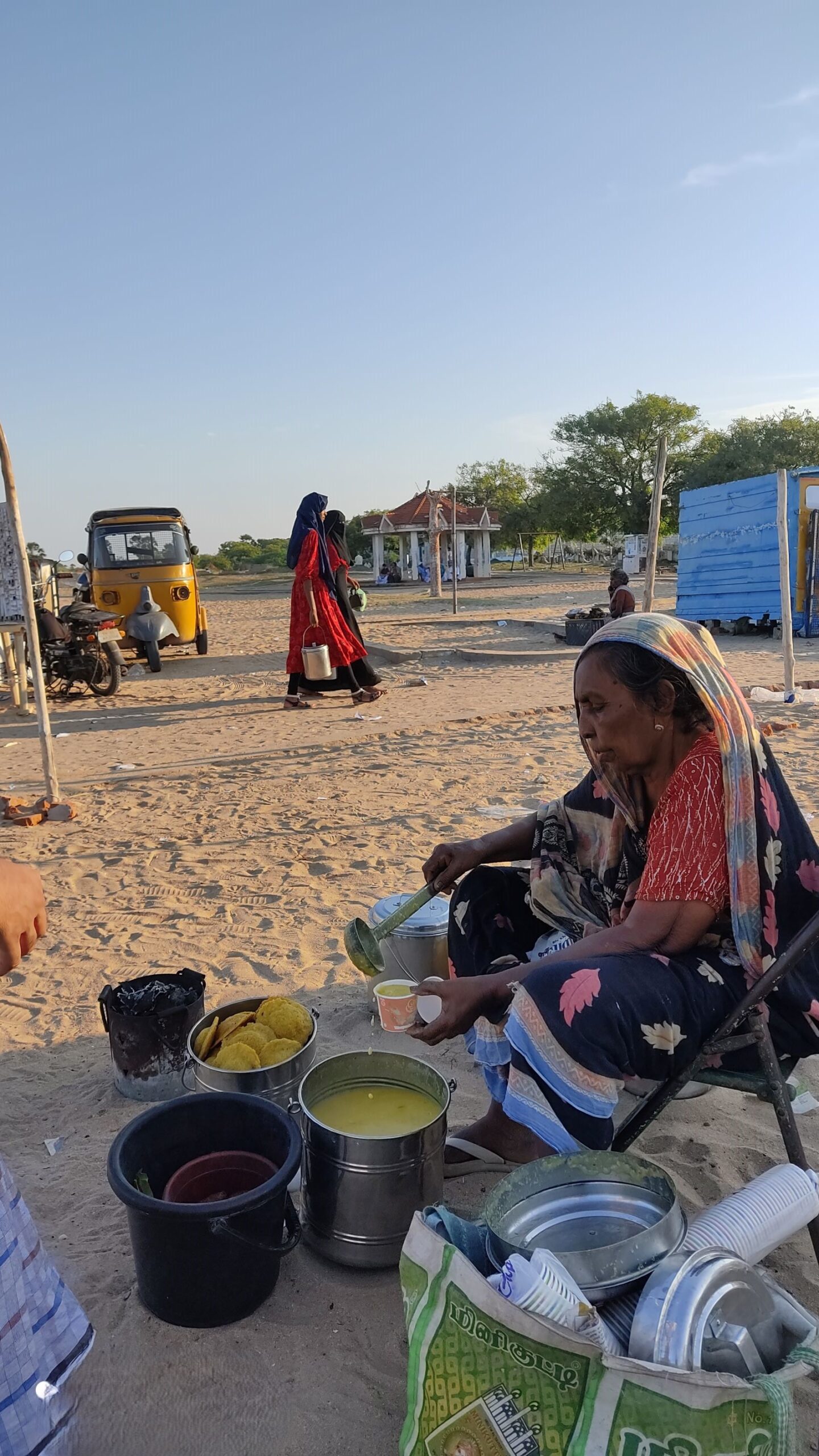
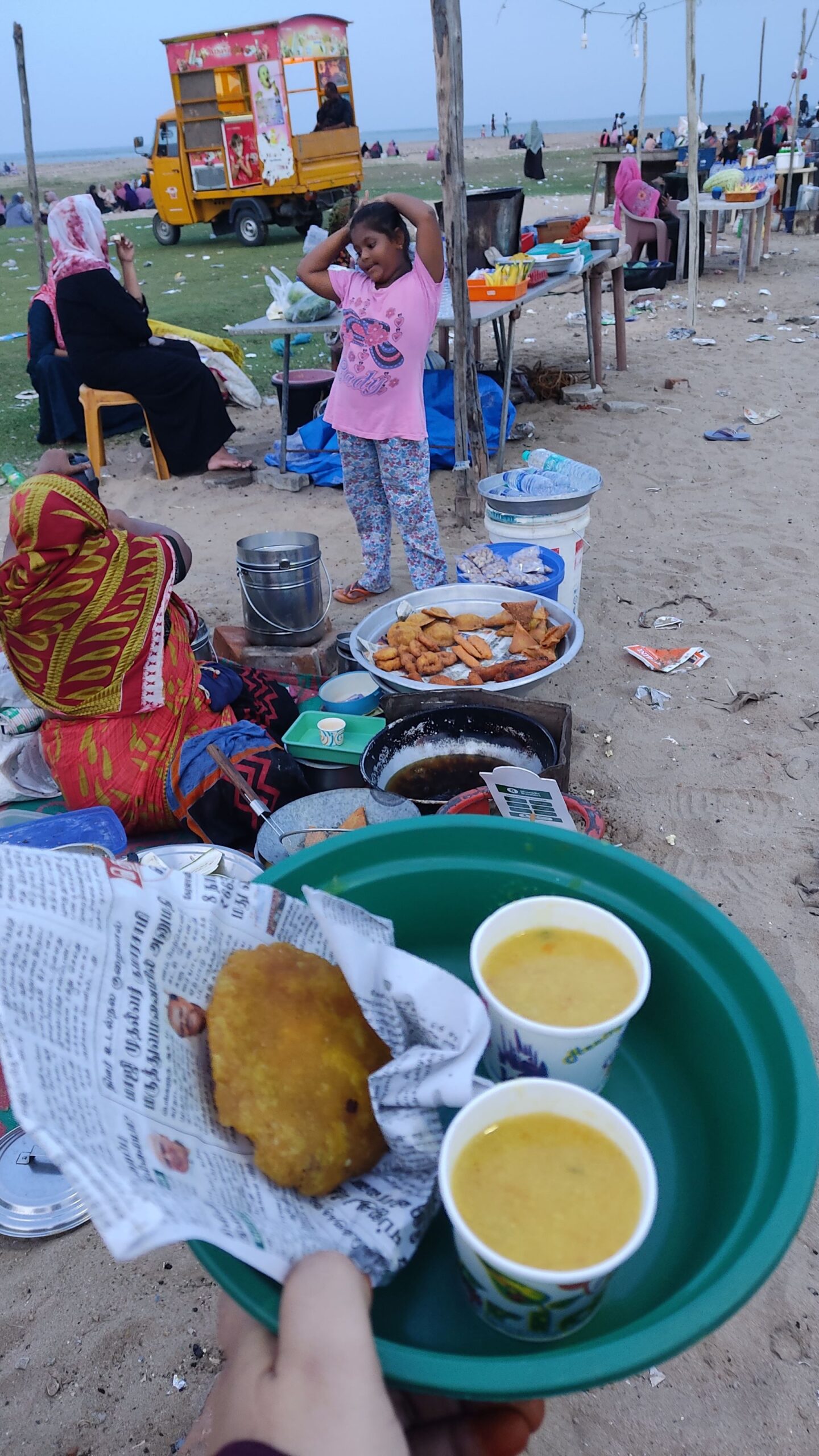
When the millennium turned, two women who sold fried snacks as well as traditional foods for families in affluent local neighbourhoods, decided to make use of their free time in the evening by selling kari kanji on the seaside. Quite quickly after, Kayalpatnam Beach became a hub of delicious recreation for anyone who wanted to relax by the seaside. Today, the beach is teeming with all manner of commerce. It’s easy for beachgoers to sulk at the amount of loitering and littering brought in by commercial activity. To vendors, however, crowded beaches are treasure chests.
Neinama Latha (the word for elder sister in the local dialect) is one of the two women who first entered into the kari kanji enterprise. I’ve been watching her since I was eight. I recently visited her stall to chat with her about kari kanji. With uncanny composure, she whirled her stainless steel ladle to pour me a paper cup of 15-rupee kari kanji. She seemed neither keen to answer my clichéd questions nor indifferent. She said that before setting up this business on the beach almost three decades ago, she had multiple jobs. She sold fried food in the morning, prepared feasts for weddings, and sold appams at night by her thatched hut. But ever since she began selling kari kanji on the beach, she finds that just this enterprise sustains her livelihood. Her rival, the other lady who used to sell kanji, happened to be my childhood friend’s paternal grandmother, who is sadly no more. Death softens rivalries. I always remember them vying with each other for orders, but now Semarma Latha only thinks fondly of her erstwhile competition.

